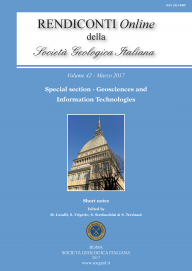
3D Remote survey of a rock wall hosting a multi-sensor monitoring system in a test-site (Acuto, Italy)
Andrea Fantini (a,b), Matteo Fiorucci (a), Salvatore Martino (a) & Paolo Sarandrea (b)
(a) Sapienza Università di Roma - Dipartimento di Scienze della Terra e Centro di Ricerca CERI - Piazzale Aldo Moro, 5, I-00185, Roma, Italia.
E-mail: matteo.fiorucci@uniroma1.it.
(b) Tecnostudi Ambiente S.r.l., P.zza Manfredo Fanti, 30, I-00185 Rome. Corresponding author e-mail: andrea.fantini@tecnostudiambiente.it.
Volume: 42/2017
Pages: 30-33
Abstract
A multi-sensor monitoring system was installed in an abandoned quarry at Acuto (Frosinone - Central Italy) to test multi-sensing and multi-parametric remote techniques for early warning in
case of rock failures threating strategic infrastructures. The multisensory monitoring system consist in: i) a meteo-climatic system, including a conventional weather stations and an innovative TSA-BOX
one; ii) a geotechnical system, including thermometer for the rock mass temperature, strain-gauges for micro-fractures of rock mass, extensometers on open joints for detecting stress-strain conditions; iii) a nanoseismic monitoring system was also temporary installed to detect low magnitude vibrations to be regarded as precursors of rock failures. To correctly design the multi-parametric monitoring system, the rock wall was scanned to identify the main joint sets.
Three GPS monographs were preliminary obtained in order to spatially geocoding the rock wall. From November 2015 to May 2016 remote scanning surveys were carried out on the quarry face by two different approaches: i) topographic 3D survey by Leica Total Station; ii) optical survey by 3D photos technique analyzed by Structure from Motion technique. The topographic survey provided high definition geocoded point clouds. These outputs were compared with the ones obtained by the SFM technique on 3D photos to test their reliability. At this aim, a Gaussian bi-modal distribution of the surveyed distances was obtained from each measurement; the comparison among the so derived distributions demonstrates that the computed errors are negligible and the main differences result at the boundaries of the sampled 3D domain. This comparison encourages the use of the photography technology by SfM technique to obtain multi-temporal geocoded point clouds for change detection analyses to point out evidences of scar zones due to slope failures. This
approach guarantees a very quick and accurate practice with easy management hardware and low software costs.
Keywords
Get Full Text